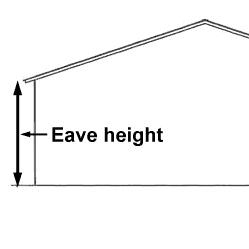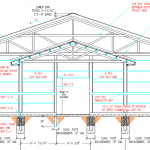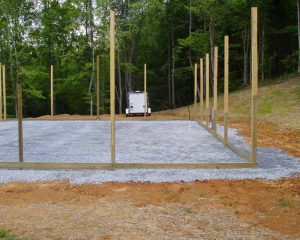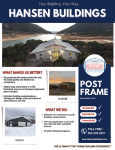My regular “day job” is as Technical Director for Hansen Pole Buildings. This is a fancy title for, “the guy who solves problems when things go astray”.
DIYers are frankly hilarious, as they come holding hat-in-hand saying things like, “You wouldn’t believe what I’ve done wrong, it has to be the worst mistake ever!”
In my 1990’s past life, I was a post frame contractor, running as many as 35 building crews at a given time across six Western States. To the DIYers, I let them know, “Even though I had some really great post frame builders, if a construction error could possibly be done, chances it is named after one of my crews.”
Now recently it was posed to me, “What one question do post frame builders most often ask?”
This was an easy answer, but perhaps one most would not expect, it is, “Why is my wall steel ____ (fill in the blank with amounts anywhere from 3 to 12 inches) too short?”
Usually this is quickly followed with something from a client or builder resembling, “You guys are stupid and your engineer is an idiot!”
 A few years ago the ASABE (American Society of Agricultural and Biological Engineers) set out to establish a standard for uniformity in terms used in the design, construction, marketing and regulation of post frame building systems. This document, approved as an American National Standard (ANSI/ASABE S618) in January 2011, provides definitions and classifications associated with post-frame building systems.
A few years ago the ASABE (American Society of Agricultural and Biological Engineers) set out to establish a standard for uniformity in terms used in the design, construction, marketing and regulation of post frame building systems. This document, approved as an American National Standard (ANSI/ASABE S618) in January 2011, provides definitions and classifications associated with post-frame building systems.
On the surface, it would seem this standard should have kept my $64,000 question from being asked.
Here are some highlights, which would address “eave height” which ultimately could influence how long the wall steel should be:
“10.11 Eave height: Vertical distance between the floor level and the eave line.”
“10.2 Floor level: Elevation of the finished floor surface. In the absence of a finished floor, the floor level is taken as the elevation of the bottom edge of the bottom girt.”
NOTE: Bottom girt may also be known regionally by terms such as: Grade girt, Splash plank, Skirt board or similar.
“10.3 Eave line: Line formed by the intersection of the plane formed by the top edge of the purlins and the plane formed by the outside edge of the sidewall girts.”
Some of this is going to be open to interpretation (otherwise known as “clear as mud”). Does this mean a 14’ eave height building designed without a concrete floor, becomes a 13’8-1/2” eave height if a nominal four inch thick concrete floor is later poured using the bottom girt as a concrete form? Some post frame building kit package providers show on their plans excavating below the bottom edge of the bottom girt to allow for a future concrete floor – where is eave height then measured?
There are some who design buildings with the wall framing inset so the outside of the wall girts are in the same plane as the face of the structural columns. Others place bottom girts, wall girts and other wall framing members on the face of the columns (making the framed up building in this case three inches greater in width and length). How this 1-1/2” of framing change is accounted for can vary the length of wall steel by ½” at a 4/12 roof slope – with the difference becoming greater as the roof slope is increased.
In our case – we crafted what we felt was a clarification of how to measure eave height as, “The vertical measure from lower edge of bottom girt to intersection of underside of roofing and outside edge of sidewall columns”. I’ve counted and this description is on each of our blue prints at least seven times (across three different pages).
Last year Justine, the materials coordinator in our office, got a call from a builder who was constructing one of our building kits. The gist of the call being, “your wall steel is eight inches too short!”
Now this post frame builder did admit to having framed the building three inches taller than he should have. His reasoning – to compensate for the building having end overhangs (the thickness of the end overhang happening to be six inches). Obviously, this made far more sense to the builder, than to have followed the building plans and instructions.
Justine astutely asked him to measure the height of the building, from bottom of the pressure treated splash plank, to the top of the eave girt at the sidewall columns. Of course she knew the answer was supposed to be 14 feet, so she wasn’t overly surprised when the builder told her 14’9”!
The correct measure of eave height is shown on almost every page of the plans (along with text description of how to measure it) and also stated repeatedly in the Construction Manual provided with every purchase. Besides diagrams and photos with clear marking of dimensions, comes written encouragement for anyone not understanding eave height to call us.
In almost every case the difference to be corrected is 3-1/2” (where the builder had the idea he needed this added to compensate for the thickness of the nominal four inch thick slab), 6” (height got measured to the bottom of the truss from the bottom of the bottom girt) and 9-1/2” – when both errors are made.
As I tell DIYers and post frame builders, there is no problem which cannot be solved. This is no different.
The no cost in lumber or steel solution is to remove the bottom girt and move it up the post by the distance needing to be made up. This does result in lots of fill needing to be added to bring grade up to the bottom of the bottom girt. There is a side benefit to relocating the bottom girt, as the building is far less likely to have water pouring into it, in the event of a deluge or tremendous snow melt.
Add another wall girt directly on top of the bottom girt. If it is going to be exposed to the weather, it needs to be pressure preservative treated. This result may not be aesthetically pleasing to new building owners, however, as it leaves a great deal of treated lumber exposed.
Or, more expensive solutions, which include:
Add a piece of custom trim at the top of the wall;
Cut the wall steel off shorter and add wainscot panels;
Replace the wall steel.
Of course the best solution is to avoid the problem. Plans vary greatly from provider to provider and engineer to engineer. Rather like the “measure twice, cut once” adage, a few minutes spent perusing provided building plans and installation instructions can avoid embarrassment as well as expense.









